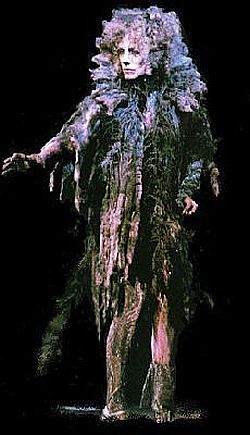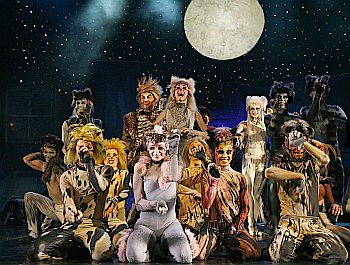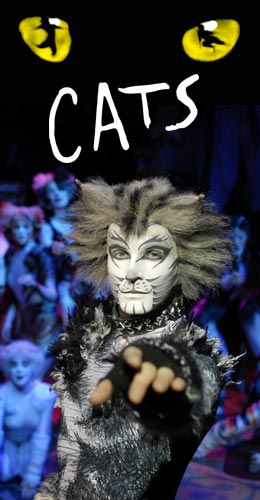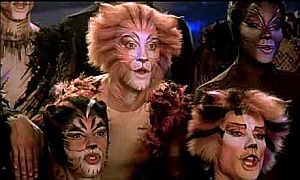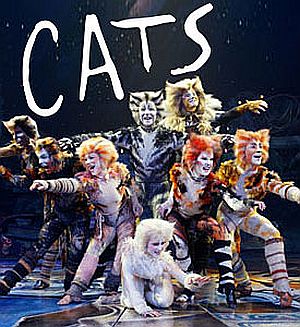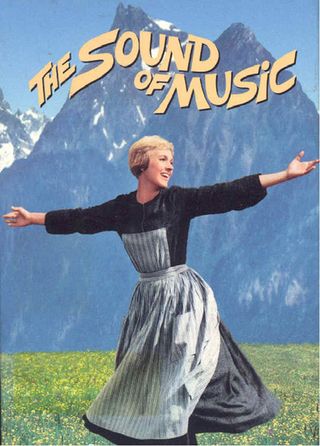 A poster for the 1965 film version of Rodgers & Hammerstein’s ‘The Sound of Music,’ one of many R&H productions that have yielded long-lived economic returns in music, film, and continuing stage productions. Click for 50th anniversary DVD edition.
A poster for the 1965 film version of Rodgers & Hammerstein’s ‘The Sound of Music,’ one of many R&H productions that have yielded long-lived economic returns in music, film, and continuing stage productions. Click for 50th anniversary DVD edition. “I see musicals as a very big growth area for investment,” said André de Raaff, chief executive of Imagem Music Group
in April 2009. Mr. de Raaff’s company had just acquired the rights to a mother lode of Broadway hits by music legends Richard Rodgers and Oscar Hammerstein. Imagem is owned by a giant Dutch pension fund and the European media company CP Masters. The company is believed to have paid some $250-to-$300 million for the rights to the Rogers and Hammerstein treasures. The deal was first reported on April 21, 2009.
Richard Rodgers (1902-1979) and Oscar Hammerstein (1895-1960) were the re- nowned American songwriting team who created a string of popular Broadway musicals in the 1940s and 1950s.
“Rodgers & Hammerstein,” as they are popularly known, reigned over what is considered the golden age of Broadway. Richard Rodgers did the composing and Oscar Hammerstein the writing.
The musicals with their songs — and the film versions that typically followed — garnered an impressive array of awards over the years, among them some 34 Tony awards, 15 Academy Awards, two Pulitzer Prizes, and two Grammys. Five of their shows — Oklahoma!, Carousel, South Pacific, The King and I, and The Sound of Music — became runaway successes and are now regarded as musical icons. The music from these shows — and other Rodgers & Hammerstein work — remains popular among millions around the world and is regarded as a business gold mine.
In the deal that Imagem made, it acquired not only Rodgers & Hammerstein rights, but others as well, covering some 12,000 songs, 900 concert works, 100 musicals, and 200 writers. Among these are compositions by Irving Berlin and Mr. Rodgers’s other collaborator, Lorenz Hart. Irving Berlin’s song “White Christmas” — one of history’s top-selling songs ever — and his hit musical, Annie Get Your Gun, are also included, as are the Rodgers & Hart songs “Pal Joey” and “The Lady is a Tramp.” Imagem made its deal with the New York city-based Rodgers & Hammerstein Organization (RHO), which formerly managed all of this material. Imagem essentially acquired the RHO organization wholesale, retaining its existing management staff.
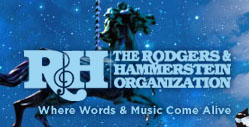 The Rodgers & Hammerstein Organization was created in 1943 to manage the works of Richard Rodgers & Oscar Hammerstein.
The Rodgers & Hammerstein Organization was created in 1943 to manage the works of Richard Rodgers & Oscar Hammerstein. “The sale represents a transfer of power over one of America’s most famous song catalogs and the licensing rights for future productions of the musicals,” wrote New York Times reporter Patrick Healy. RHO president and executive director, Theodore S. Chapin, who agreed to stay on at RHO, suggested that Imagem’s global reach would help RHO find new licensing deals for their holdings in Europe and Asia. “[S]ince Imagem is global,” he said, “I hope they can help us disseminate the works we represent with a little more moxie.”
Over the years, RHO had run its business fairly conservatively, collecting royalties from tens of thousands of licenses it issued for theatrical productions of R&H works. They also issued thousands of licenses for performances and recordings of their copyrighted songs, musicals, and concert works. Imagem’s deal with RHO covers some 12,000 songs, 900 concert works, 100 musicals and 200 writers. By 1990, for example, RHO was licensing about 3,000 productions a year and its music-publishing division employed about 20 people. RHO had been run in recent years by two Rodgers & Hammerstein heirs — daughters Mary Rodgers Guettel and Alice Hammerstein Mathias, who appeared satisfied with the deal they made with Imagem. Speaking on behalf of the Hammerstein family, Alice Hammerstein Mathias stated: “The collaboration between my father and Richard Rodgers was extraordinary. That they kept everything together, including the management of their copyrights, is a testament to their shared vision, and now that vision will be continued in this promising new venture.” Added Mary Rodgers Guettel: “My father always believed in moving forward. This is a big and wonderful step, and I am thrilled by the new opportunities that André and his team bring to my father’s songs and shows…”
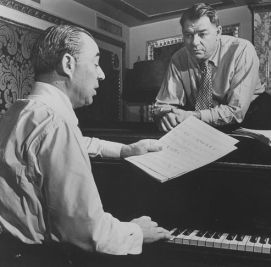 The composer Richard Rodgers, left, and the lyricist Oscar Hammerstein at work in 1953.
The composer Richard Rodgers, left, and the lyricist Oscar Hammerstein at work in 1953.
Rodgers & Hammerstein
RHO was initially founded by Richard Rodgers and Oscar Hammerstein in 1943, then for the purpose of controlling their own musicals, and additionally, those of Rodgers and Lorenz Hart, some separate Hammerstein works, and later other properties such as Irving Berlin’s Annie Get Your Gun of 1946.
In the early 1940s, by the time Rodgers and Hammerstein came together for their extended collaboration, they had each had separate careers. They were both over 40 by then.
Hammerstein had success in the 1920s, helping create stage hits with operetta-style musicals such as Rose-Marie of 1924 and The Desert Song of 1926.
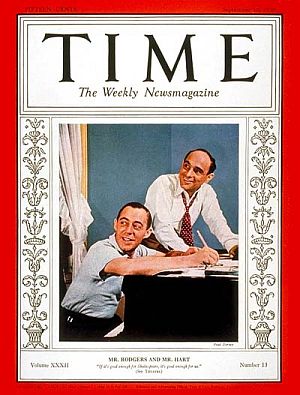 Richard Rodgers and Lorenz Hart on the cover of Time magazine, September 26, 1938. Richard Rodgers and Lorenz Hart on the cover of Time magazine, September 26, 1938. |
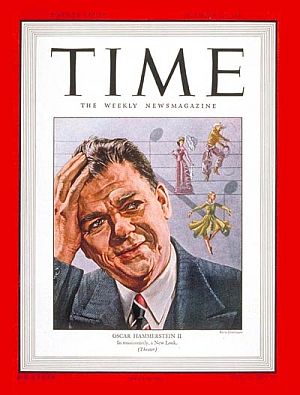 Oscar Hammerstein II on the cover of Time magazine, October 20, 1947. Oscar Hammerstein II on the cover of Time magazine, October 20, 1947. |
In 1927, his hit musical Show Boat(with Jerome Kern), broke new ground on Broadway on a number of fronts, becoming the first, as they say, to integrate “book, music and lyrics” into a coherent whole.
Show Boat, known for Paul Robeson’s classic performance of “Old Man River,’ also broached several social issues, among them, addictive gambling, alcoholism, racism and interracial marriage.
Hammerstein, in fact, would become known as a key innovator and “book writer” on Broadway — making the story, not the songs or the performers, central to the production. Still, by the early 1940s, Hammerstein’s good fortune had evaporated and he went for about ten years without a hit show.
Richard Rodgers on the other hand, working with lyricist Lorenz Hart, had composed the scores for a number of hit shows that included: On Your Toes (1936), Babes in Arms (1937), The Boys From Syracuse (1938), Pal Joey (1940), and By Jupiter (1942). More than 80 popular tunes came from those works.
Both Rodgers and Hart were featured on the cover of Time magazine in September 1938. But Hart’s health was in decline and he passed away in 1943.
Rodgers and Hammerstein, who had worked together on occasion in the past, came together again in the early 1940s to work on what would became Oklahoma! This production furthered what Hammerstein had started in Show Boat — focusing on story, and integrating all aspects of the musical around plot and characters. Oklahoma! began the string of major Rodgers & Hammerstein successes, five of which are explored in more detail below.
Between them, Rodgers and Hammerstein had a prolific output over the years. Hammerstein wrote an estimated 850 songs; Rodgers composed more than 900. Their work, either separately or together, is found in more than 40 Broadway musicals, and indirectly in many others, as well as Hollywood films and television adaptations.
Hammerstein died at the age of 65 shortly after the opening of The Sound of Music in 1960. Rodgers died in 1979 at age 77.
|
“Rodgers & Hammerstein Gold”
Some of Their Selected Works
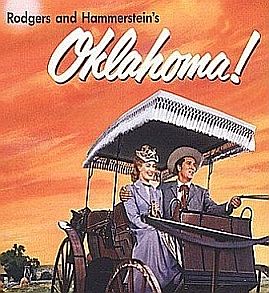 ‘Oklahoma!’ opened in March 1943 and ran for 2, 212 performances. Click for film DVD. ‘Oklahoma!’ opened in March 1943 and ran for 2, 212 performances. Click for film DVD.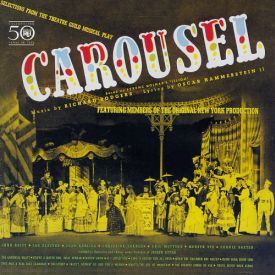 Cover of cast album for ‘Carousel,’ first opened on Broadway in April 1945. Click for vinyl, CD, or digital. Cover of cast album for ‘Carousel,’ first opened on Broadway in April 1945. Click for vinyl, CD, or digital. Carousel, set between 1873 and 1888 in a New England coastal village in the state of Maine, tells the tale of a love affair between Billy Bigelow, a traveling, carefree carnival man, and Julie Jordan, a local factory worker. Billy loses his job just as he learns that Julie is pregnant and, desperately intent upon providing a decent life for his family, he is coerced into being an accomplice to a robbery. Caught in the act and facing the certainty of prison, he takes his own life. When he reaches Heaven, he is denied entry because of his terrible deeds. Years later, Billy is allowed to return to Earth for one day, where he encounters the grown daughter he never knew, now besmirched by her father’s former reputation. Billy seeks to instill in both his daughter and her mother a sense of hope and dignity. When the play first ran, The New York Daily Mirror wrote: “(Carousel is) beautiful, bountiful, beguiling…it is the product of taste, imagination and skill.”. In December 1999, Time magazine named Carousel the Best Musical of the 20th century on its “Best of the Century” list, with the editors adding that Rodgers and Hammerstein “set the standards for the 20th century musical”. Carousel is especially well-regarded in the theater community, and Richard Rodgers called it his favorite musical. 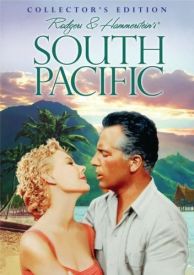 DVD cover of 1958 film version of ‘South Pacific.’ Click for DVD or video. DVD cover of 1958 film version of ‘South Pacific.’ Click for DVD or video. South Pacific, a Rodgers and Hammerstein stage production, opened on Broadway in April 1949. A U.S. tour ran for almost five years in 118 cities from April 1950 through March 1955. Among its popular songs are: “Bali Ha’i,” “Younger than Springtime,” and “Some Enchanted Evening.” Based upon short stories from James A. Michener’s Tales of the South Pacific, Rodgers and Hammerstein, along with co-writer Joshua Logan, won a 1950 Pulitzer Prize for their adaptation. The original production featured Mary Martin as Nellie Forbush a naive young Navy nurse from Arkansas and opera star Ezio Pinza, as Emile de Becque, a French plantation owner. In the story, these two main characters become romantically involved. The story, set in World War II, also involves the frustrations of bored military men stationed on the South Pacific islands with too few women around. Racism is also a part of this story, emerging when Nellie learns that Emile has fathered dark-skinned Polynesian children with a former partner, and another character, Cable, refuses to marry a local Vietnamese girl.
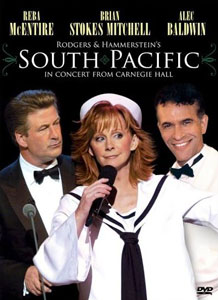 Concert version of ‘South Pacific’ at Carnegie Hall, telecast by PBS in 2006. Concert version of ‘South Pacific’ at Carnegie Hall, telecast by PBS in 2006. 50th anniversary edition DVD for Rodgers & Hammerstein’s ‘The King and I’. Click for DVD or video. 50th anniversary edition DVD for Rodgers & Hammerstein’s ‘The King and I’. Click for DVD or video. Rodgers and Hammerstein had the benefit of a 1946 film version of the novel preceding their own work, which was first proposed as a musical to them by the actress Gertrude Lawrence who wanted and got the leading role. In the production, The King is largely considered to be a barbarian by those in the West, and he seeks Anna’s assistance in changing his image, if not his ways. Although both Anna and King hold fast to their respective traditions and values, they grow to understand and respect one another, and become involved in a unique kind of love story. This Rodgers and Hammerstein production resulted in a number of hit songs, including: “I Whistle a Happy Tune”, “Hello, Young Lovers,” “Getting to Know You,” “We Kiss in a Shadow,” “Something Wonderful,” “I Have Dreamed,” and “Shall We Dance?”
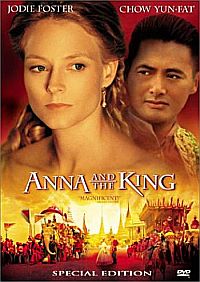 Jodie Foster & Chow Yun-Fat in 1999 film, 'Anna and The King'. Click for film. Jodie Foster & Chow Yun-Fat in 1999 film, 'Anna and The King'. Click for film. In 1956, a Hollywood film adaptation was made starring Yul Brynner and Deborah Kerr. It won five Oscars including one for Brynner as Best Actor. The King and I returned to Broadway in 1977 and 1985, and also as a short-lived 1972 TV sitcom, Anna and the King. Yul Brynner, over the course of 34 years, played The King more than 4,600 times, first on stage, then on the big screen, and also on the television series. In the first week of January 1985, as Brynner began his final engagement in the play at the Broadway Theatre, a new Broadway record was set for advance ticket sales in a single week, grossing $1,541,547. Another Hollywood film version, Anna and The King, starring Jodie Foster and Chow Yun-Fat , was produced in 1999, though with many differences from the musical production.
 Poster for 1965 film version of Rodgers & Hammerstein’s ‘The Sound of Music.’ Click for poster. Poster for 1965 film version of Rodgers & Hammerstein’s ‘The Sound of Music.’ Click for poster. A movie version of The Sound of Music produced in 1965 by 20th Century Fox starred Julie Andrews and Christopher Plummer. It won five Oscars, including Best Picture and Best Director. The film premiered at the Rivoli Theatre in New York city in March 1965, where it ran for 93 weeks.In 2005, Box Office Mojo listed The Sound of Music as the third-biggest-gross- ing film of all time at the domestic box office. The movie’s initial run in the U.S. release lasted four-and-a-half years, prompting Variety magazine at the time to proclaim it the “all-time box office champion.” In 2005, Box Office Mojo listed The Sound of Music as the third-biggest-grossing film of all time at the domestic box office, at $911.5 million, adjusted for inflation. Only Gone with The Wind and Star Wars grossed more. When the home video version first became available in 1979, it set sales records and hit the Billboard Top 40 video sales chart, remaining on the chart for more than 300 weeks. Today, The Sound of Music remains one of the top grossing films of all time and is perhaps the world’s most popular musical ever made. The motion picture soundtrack, released by RCA, has sold over 10 million copies worldwide, and home video sales of the film in VHS and DVD formats, have done quite well too.
Too Sugary?
Over the years, the works of Rodgers and Hammerstein have held up quite well for their musical and production values, although receiving sharp criticism at times for being too sugary and too goody-goody in terms of the social values conveyed. In 1993, New York Times writer Stephen Holden offered this synopsis of the Rodgers and Hammerstein era: “Once upon a time, America dreamed of itself as a singing fairy tale for grown-ups, with a happy ending. Norman Rockwell painted this storybook country, and Richard Rodgers and Oscar Hammerstein wrote its songs. More than just pop confections, they added up to a kind of secular catechism that sweetly but firmly instructed people on the rules of behavior in a world where America knew best and good triumphed over evil…”
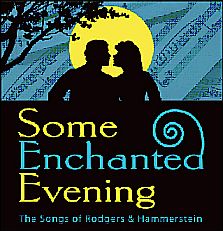 Rodgers & Hammerstein -- 'too sugary'? Rodgers & Hammerstein -- 'too sugary'? Holden concluded in his 1993 piece: “The America of Rodgers and Hammerstein — where the good guys won, love conquered all and progress was taken for granted — was itself a dream, a golden bubble of postwar hope and confidence that evaporated more than it burst.” True enough. Yet the Rodgers & Hammerstein works live on in the hearts of many, and still serve the values espoused, tempered, of course, by their own times. Hope and optimism, it seems, even if too sugary, are hard to extinguish. And certainly in terms of musical influence, Rodgers and Hammerstein continue to be heard in the strains of many pop ballads to this day.
|
Musical Value
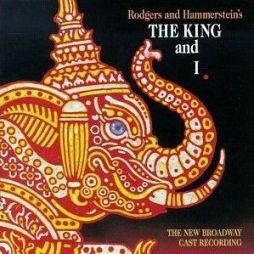 Cover of 1996 CD for cast recording of R&H musical, ‘The King and I’. Click for CD.
Cover of 1996 CD for cast recording of R&H musical, ‘The King and I’. Click for CD. The Rodgers & Hammerstein acquisition by Imagem offers a continuing source of economic value for its new owners. Fees from music publishing rights can be collected from a broad range of uses, and many of these are not vulnerable to piracy. While the major record labels have suffered in recent years with declining sales due to changing technology, music publishing rights are still quite lucrative. This part of the music business has held its value far better than recordings.
Music publishers make money when songs are played on the radio, in restaurants and bars, and when any version of a song is used in a movie, TV show, video game, or commercial advertisement. Also, other artists singing Rodgers & Hammerstein tunes — called “cover versions” — require license arrangements and yield standard royalties. The Rodgers & Hammerstein properties already have an extensive track record of doing business of one kind or another, and more is expected.
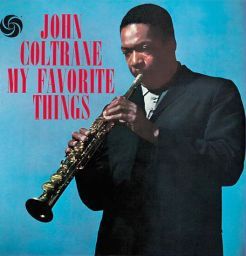 John Coltrane’s 1961 album includes rendition of ‘My Favorite Things.’ Click for CD or digital.
John Coltrane’s 1961 album includes rendition of ‘My Favorite Things.’ Click for CD or digital. “My Favorite Things” from
The Sound of Music, for example — made popular during its Broadway run and with Julie Andrews in the film version — has been used in advertising. In the late 1980s and early 1990s, the song was used in automobile commercials for Mitsubishi. In 2007, it was used in advertisements for the Skoda Fabia, a mini-car produced by Czech auto maker Škoda, owned by Volkswagen. It was also used that year in Master Card ads, one of which featured actress and singer Penelope Fortier.
“My Favorite Things” has also become a jazz standard, with John Coltrane’s album of the same name becoming a historic landmark of sorts, which helped spark the rediscovery of soprano sax. The song has also been performed by a range of artists in jazz and other styles, including: Stanley Jordan, Grant Green, Carmen Lundy, Dave Brubeck, Bill Evans, McCoy Tyner, Kenny Rogers, Tanya Tucker, Rod Stewart, Sarah Vaughan, The Supremes, the Gimme Gimmes, Kimiko Itoh, Tony Bennett, 2Pac, Barbra Streisand, Tennessee Ernie Ford, Andy Williams, Luther Vandross, and others.
“Climb Ev’ry Mountain,” another Sound of Music song, was used by Australian Idol contestant Guy Sebastian in 2003 when he performed it on Australian TV in the show’s first season there. Sebastian went on to win, becoming the first Australian Idol, and in 2004 he recorded “Climb Ev’ry Mountain” on his No.1 single, “All I Need Is You.” The Rodgers & Hammerstein song was also adapted for National Australia Bank’s “Confidence” TV ad campaign in 2007.
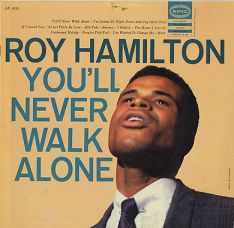 In 1954, Roy Hamilton’s version of ‘You'll Never Walk Alone’, became an R&B No.1 hit for eight weeks and a national Top 30 hit, boosting Hamilton to fame. Click for digital.
In 1954, Roy Hamilton’s version of ‘You'll Never Walk Alone’, became an R&B No.1 hit for eight weeks and a national Top 30 hit, boosting Hamilton to fame. Click for digital. Over the last 60 years, “You’ll Never Walk Alone” — a song from
Carousel — has been recorded by dozens of artists, some charting as hit songs in their time of play. Among those covering this song, for example, have been Frank Sinatra, Judy Garland, Gerry & The Pacemakers, Elvis Presley, Roy Hamilton, Johnny Cash, Tom Jones, Renée Fleming, Nina Simone, Gordon MacRae, Ray Charles, Patti Labelle, the Righteous Brothers, Dionne Warwick, and others. The song is also a popular anthem for European soccer teams and has been used to help raise money for disaster victims and hurricane relief. Jerry Lewis has used the song for years during his Labor Day Muscular Dystrophy telethons. It has also been sung by Joan Baez, Marilyn Horne, Patti LaBelle and others in association with AIDS Walk campaigns and rallies in New York, Los Angeles, San Francisco, Philadelphia and Chicago. In 2002, opera star Renee Fleming sang “You’ ll Never Walk Alone” at Ground Zero during first year commemoration of the 9/11 attacks. In 2009 she sang it again, this time globally telecast from the steps of the Lincoln Memorial at the Inauguration of President Barack Obama.
|
“You’ll Never Walk Alone”
When you walk through the storm
Hold your head up high
And don’t be afraid of the dark
At the end of the storm
There’s a golden sky
And the sweet silver song of the lark
Walk on, through the wind
Walk on, through the rain
Though your dreams be tossed and blown
Walk on, walk on, with hope in your heart
And you’ll never walk alone
You’ll never walk alone
Walk on, walk on, with hope in your heart
And you’ll never walk alone
You’ll never walk alone
|
Rodgers & Hammerstein’s “Some Enchanted Evening” from South Pacific was recorded by a succession of popular artists in the first year of its release, 1949, including: Frank Sinatra, Perry Como, Jo Stafford, Bing Crosby, Ezio Pinza (original cast recording), and Al Jolson. But in later years as well, others also did versions of the song, including Willie Nelson, Jay and the Americans, and Barbra Streisand. Jon Bon Jovi did it on the Ally McBeal TV show, and even Harrison Ford did a version in the film American Graffiti.
“People Will Say We’re in Love” from Oklahoma! has also been covered by dozens of artists, some resulting in early Top 40 hits — Bing Crosby ( No.2), Frank Sinatra ( No. 3) and The Ink Spots ( No. 11).
“Hello, Young Lovers” from 1951’s The King and I was covered that year by Perry Como and Guy Lombardo with Kenny Martin. Earl Grant did the song on his 1958 album The End. Bobby Darin did an upbeat swinging version of the song, and Paul Anka had a popular 1960 version in the Bobby Darin style.
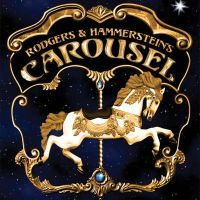 Poster art for a production of Rodgers & Hammerstein’s ‘Carousel'.
Poster art for a production of Rodgers & Hammerstein’s ‘Carousel'. RHO, despite this history of success, has not been the most aggressive marketer of its portfolio’s possibilities. Primarily, it has been content to steadily licence its shows for stage productions, while limiting the exposure of its classic works in an attempt to protect their value.
It is known, however, that there is increasing demand for use of R&H material in film and television. But in the past, RHO has usually denied these kinds of uses because they sought to uphold the artistic integrity of their work, only licensing it for theatrical production and concerts. Imagem, on the other hand, is expected to seek a fuller range of marketing options.
|
Imagem’s Playlist
Sample List*
“Love & Affection”
– Joan Armatrading
“As Long As You Love Me”
– Backstreet Boys
“Think Twice”
– Celine Dion
“Numb”
– Linkin Park
“Take A Bow”
– Rihanna
“When The Going Gets Tough”
– Billy Ocean
“You Are Not Alone”
– Michael Jackson
“Ray Of Light”
– Madonna
“Karma Chameleon”
– Culture Club
“Baby One More Time”
– Britney Spears
“American Idol Theme”
– American Idol
“Since You’ve Been Gone”
– Kelly Clarkson
“Rock Your Body”
– Justin Timberlake
“I Believe I Can Fly”
– R. Kelly
“Who Do You Think You Are?”
– Spice Girls
“All Summer Long”
– Kid Rock
“Run To The Hills”
– Iron Maiden
“Thunder in My Heart”
– Leo Sayer
____________________
*Imagem Music Group holds rights
to about 100,000 songs. Source:
www.imagem-music.com
|
Imagem’s Portfolio
Imagem, however, is something of a newcomer to the global music and entertainment industry. It was founded in 2008 by ABP, one of the world’s biggest pension funds ($223 billion), in conjunction with Dutch independent music publisher and media company CP Masters. ABP is the pension fund for some 2.6 million persons and employers who work for the Dutch government or its education system.
Imagem began building its business by acquiring other music publishing rights and music catalogs. After Universal Music Group bought Bertelsmann’s BMG music-publishing unit, several of its pop music catalogs were spun off to satisfy federal anti-trust regulators — Zomba UK, Rondor UK, 19 Music, and 19 Songs. Imagem then picked up these catalogs.
As of mid-2009, Imagem’s collection included a number of tunes from pop artists such as those in the box at right, including: Madonna, Linkin Park, Celine Dion, Justin Timberlake and others. From its London location, Imagem manages its back catalog and has a roster of 40 writers creating new music. It also seeks out and signs new talent, recently signing, for example, artists such as Australia’s Jarrad Rogers and the Portico Quartet.
In April 2008, Imagem acquired Boosey & Hawkes, a large classical-music publisher, whose catalog includes works of renowned artists such as, Benjamin Britten, Aaron Copland, Serge Prokofieff, Igor Stravinsky, and Sergei Rachmaninoff. This catalog also includes jazz and other works by artists and composers such as Karl Jenkins, Elliott Carter, John Adams, and Wynton Marsalis. Boosey and Hawkes is also involved in the market for music in advertising and film, where revenues are currently growing at about 30 percent annually per annum, according to Imagem. Other clients at Boosey & Hawkes include orchestras, choirs, record companies, and radio stations.
In the April 2009 deal with RHO, Imagem also acquired works by other artists including Adam Guettel, Sheldon Harnick, Jerome Kern, Stephen Schwartz, Kurt Weill, Lin-Manuel Miranda, and others. RHO had represented Andrew Lloyd Webber in the past, including his musicals Cats, Evita, and Joseph and the Amazing Technicolor Dreamcoat. At the time of the deal with Imagem, RHO and Webber’s group were in discussions about continuing that relationship.
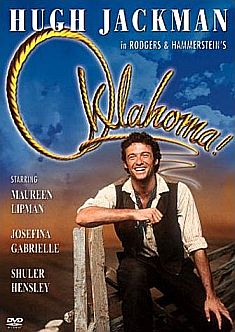 Actor Hugh Jackman on cover of a 1999 production of Rodgers & Hammerstein’s ‘Oklahoma!’. Click for Blu-ray or DVD.
Actor Hugh Jackman on cover of a 1999 production of Rodgers & Hammerstein’s ‘Oklahoma!’. Click for Blu-ray or DVD. Imagem appears eager and willing to go where other established music business interests will not go, and willing also to spend what others will not. In the recently completed Rodgers & Hammerstein deal, other potential suitors included some of the world’s biggest music publishers, among them, Warner Music Group’s Warner/Chappell Music and Sony Corp.’s Sony/ATV Music Publishing. These two had considered buying RHO, but dropped out of the bidding because they considered it overpriced, especially for a catalog of Broadway songs.
“Our purchase of the Rodgers & Hammerstein Organization is a once in a lifetime opportunity to acquire the publishing and theatrical rights of some of the most beloved shows and songs ever written,” said CEO André de Raaff at the time of the deal. He also added: “I personally believe that the world of musicals in which RHO is a leading player will grow further on a worldwide basis and we look forward to adding value to these rights through long term cultivation and development.”
Update. Since this story was first posted in 2009, Imagem and its properties have been absorbed by a larger company. On June 2, 2017, Concord, an independent creative rights company headquartered in Nashville that develops, manages and acquires music and theatrical rights, acquired Imagem for $500 million. The deal included 250,000 Imagem compositions and tripled Concord’s publishing copyrights and holdings. Imagem’s pop catalog by then also included works by Nik Kershaw, Phil Collins, Genesis, The Temper Trap, M.I.A., Pink Floyd, Vampire Weekend, Dire Straits and Daft Punk; as well as some European rights to Linkin Park and Justin Timberlake. Concord holds rights to nearly 900,000 songs, composed works, plays, musicals and active recordings – “The Sound of Money,” indeed ! For more on Concord, see Wikipedia.
For additional stories at this website on “Film & Hollywood” topics, see that category page, and for stories on music-related topics, see the “Annals of Music” page. Thanks for visiting – and if you like what you find here, please make a donation to help support this website. Thank you. – Jack Doyle
_____________________________
Date Posted: 24 June 2009
Last Update: 18 September 2022
Comments to: jackdoyle47@gmail.com
Twitter: https://twitter.com/PopHistoryDig
Article Citation:
Jack Doyle, “The Sound of Money, 2009,”
PopHistoryDig.com, June 24, 2009.
_____________________________
Sources, Links & Additional Information
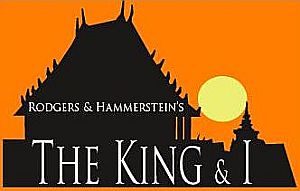 Poster art for a production of Rodgers & Hammerstein’s ‘The King & I’. Poster art for a production of Rodgers & Hammerstein’s ‘The King & I’. |
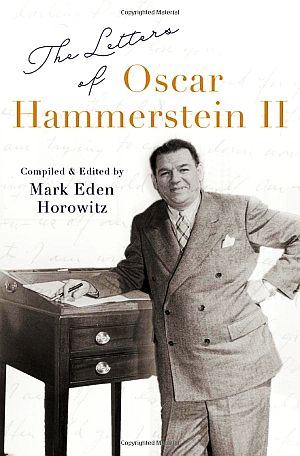 Mark Eden Horowitz’s 2022 book, “The Letters of Oscar Hammerstein II,” hardcover edition, Oxford University Press. Click for Amazon.com. Mark Eden Horowitz’s 2022 book, “The Letters of Oscar Hammerstein II,” hardcover edition, Oxford University Press. Click for Amazon.com. |
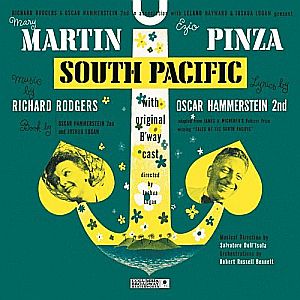 Cover of the cast album for Rodgers & Hammerstein’s 1949 production of ‘South Pacific’. Click for CD, cassette, or vinyl Cover of the cast album for Rodgers & Hammerstein’s 1949 production of ‘South Pacific’. Click for CD, cassette, or vinyl |
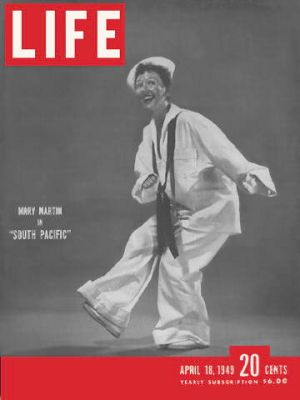 Mary Martin, co-star of Rodgers & Hammerstein’s ‘South Pacific,’ shown on the cover of Life magazine, April 18, 1949, as the show began playing on Broadway. Mary Martin, co-star of Rodgers & Hammerstein’s ‘South Pacific,’ shown on the cover of Life magazine, April 18, 1949, as the show began playing on Broadway. |
Brian Garrity, “Sale Overtures: Rodgers & Hammerstein Ouevre May Be on Block “ New York Post, September 2, 2008.
Ethan Smith, “New Partners for a Music Catalog; Dutch Investors Buy Rights to Rodgers & Hammerstein, Adding to Library,” Wall Street Journal, April 21, 2009, p. B-6.
United Press International, “Rodgers & Hammerstein Catalog Sold,” UPI.com, April 21, 2009.
Andre Paine, London, “Imagem Acquires Rodgers & Hammerstein Org,” Billboard. Biz, April 21, 2009.
The Rodgers & Hammerstein Organization, New York, NY.
Joe Dziemianowicz and Leo Standora, “Songs Sale ‘Something Wonderful’,” New York Daily News, Tuesday, April 21, 2009.
Gordon Cox, “Imagem Nabs Rodgers & Hammerstein,” Variety.com, Tuesday, April 21, 2009.
Patrick Healy, “Rodgers and Hammerstein Catalog Sold,” New York Times, April 22, 2009, p. C-3.
Press Release, “Imagem Music Group Buys R&H — Imagem Music Group Buys Rodgers & Hammerstein, Becoming World’s Leading Independent Music Publisher,” The Rodgers and Hammerstein Organization, Updated, May 22, 2009.
Andrew Lloyd Webber, “The Showmen,” Time, Monday, June 8, 1998.
“Rodgers and Hammerstein,” Wikipedia .org.
Laurence Maslon, “Memorable Musicals: Oklahoma!,” Broadway: The American Musical, A Production of Thirteen/WNET New York., PBS, The Public Broadcasting System, 2004.
Erik Piepenburg, Arts Beat Blog, “Some Enchanted Musical,” New York Times, April 6, 2009.
David W. Dunlap, Commercial Property, “Tin Pan Alley; Rodgers & Hammerstein Is Moving to Broadway,” New York Times, January 14, 1990.
“South Pacific (musical),” Wikipedia.org.
“South Pacific,” TheatreHistory.com.
“The King And I,” TheatreHistory.com.
Stephen Holden, Theater, “Their Songs Were America’s Happy Talk,” New York Times, Sunday, January 24, 1993.
Bert Fink, “From Broadway to Hollywood,” Show History, The Sound of Music, The Rodgers and Hammerstein Organization, New York, NY.
“The Gross Is Greener” (re: The Sound of Music), Time, Friday, January 14, 1966.
Todd S. Purdum, “The Hills Still Resonate,” New York Times, May 30, 2005.
Richard Corliss, “That Old Feeling: Richard Rodgers’ Century,” Time, Friday, June 28, 2002.
“Richard Rodgers,” Wikipedia.org.
Geoffrey Block, The Richard Rodgers Reader, New York: Oxford University Press, 2002.
Frederick Nolan, The Sound of Their Music: The Story of Rodgers and Hammerstein, New York: Applause Books, 2002.
Richard Harrington, “Some Enchanted Teaming; Discs Celebrate Rodgers & Hammerstein’s 50th,” Washington Post, September 8, 1993, p. D-7.
Return to Home Page.


